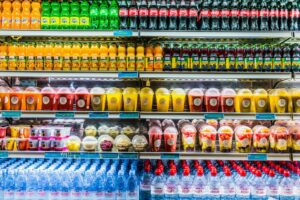Paul Davidson, Challenge Director for the Smart Sustainable Plastic Packaging challenge, UK Research and Innovation, discusses why he’s no longer talking to people about how often plastics can be recycled.
The Smart Sustainable Plastic Packaging Challenge Fund (SSPP) was established to support investment in research and innovation in plastic packaging to help the UK achieve the very stretching Plastic Pact targets. And it’s one of these targets – that, by 2025, all plastic packaging should contain an average of 30% recycled content. When discussing this target I very often hear the question being asked “so how many times can plastic be recycled then?” usually after a bold statement about the infinite recyclability of other materials. This would be a really interesting question if recycling was organised that way, but the problem is that it just isn’t.
We don’t gather all the plastic bottles that have been made with 100% virgin plastic, make sure they are all recycled together, then, after those are used, gather all these “first time round the loopers” and make sure these all go round together in an exclusive group. This would be incredibly difficult to achieve and counterproductive anyway. In real world recycling, material does flow in a loop but this loop has new, virgin material added – and at the same has some material removed.

From this diagram we can conclude that, rather than considering how many times plastic can be recycled, we ought to be looking at the age distribution of the polymer circulating in a specific recycling system.
Still not convinced? Imagine you are holding a handful of recycled plastic pellets. Now ask yourself how many times have these been “round the loop”. Too difficult?
So take just one pellet and ask yourself the same question… It is still unanswerable.
The truth is that even that one pellet will be a mixture of plastic that has been round once, twice, some of it even ten times or more. This is why we must instead start to consider the age distribution of the plastic in a recycling loop. Helpfully, to at least a first approximation, the steady state age distribution of plastic circulating in a recycling system does not vary with time and is determined by only two factors:
- % of articles in a system with recycled content
- % average recyclate content
From this it is possible to construct a simple model (credit: University of Liverpool) to determine the age distribution of the polymer (or any material for that matter – this is purely maths) for any given recycling scenario. So, for example, in the UK roughly 80% of HDPE milk bottles contain 30% recycled content, which will give the following age distribution.

This approach shows that the fraction of polymer that has more than three cycles is already very low and probably far lower than would otherwise be assumed. A couple of points about this:
- Each cycle contains two heat histories, one each from recycling and converting (forming into the final shape)
- The current model does not consider the additional heat history from processing process scrap e.g. tops and tails from blow moulding or skeletal scrap in thermoforming.
This approach can also be used to look at emerging recycling scenarios, for example the high recycled content increasingly found in PET bottles and trays. So, for a recycling scenario that had 80% of articles containing 50% content, the age distribution would be:

We can also use this approach to determine the consequence of differing ways to achieve recycled content targets. For example, the UK Plastics Pact requires an average recycled content of 30% to be achieved in all packaging by 2025. This target can be achieved either by distributing the PCR across all packaging or concentrating it into packaging types more amenable to recycled content, such as bottles and trays.
If this recycled content was evenly distributed across all packaging, then the circulating polymer age distribution looks technically very achievable:

However, if we rely on putting high levels of recyclate into a few pack types, the polymer age distribution becomes far more challenging. For example, if 90% of plastic bottles were required to have an 80% recycled content in order to achieve the target, then the age distribution for those bottles would be:

I doubt there are many materials people feeling comfortable about the chances that this would work! This really highlights the importance of finding ways to increase recycled content in packaging types such as film and food grade polypropylene, and why these are priority themes for us in SSPP.
Most polymers used in packaging are used directly from the polymer producer (i.e. uncompounded), which means the stabilisation system selected by the polymer producer will be critical. Packaging is a short life application and, as stabilisers are expensive, the minimum is typically added to get the polymer through its production and conversion into packaging. Typically, this is determined by the ability of the stabiliser to maintain the melt flow characteristics of the polymer after five successive extrusions.
However, this methodology gives only limited ageing and no age distribution. From the model it is clear that whilst in most recycling scenarios the fraction of more than three cycles is surprisingly low, there is also material present that can have more than 10 cycles. A very small fraction of this highly-aged material could have a disproportionate effect on the polymer, catalysing degradation. Only by introducing realistic age distributions into stabilisation experiments can this be better understood and better stabilising strategies for recycling developed. It is tempting to think that this could be solved just by adding more stabiliser during the recycling process, but, spoiler alert, this is far less effective than might be hoped.
What about chemical recycling? Well, after promising so much for so long it does look like chemical recycling of plastics is, at last, starting to take its place in wider recycling activity – partly through SSPP funding. For processes that return the plastic to starting feedstock, this material should, from the model’s perspective, be considered virgin – as it is indistinguishable from virgin material made from traditional feedstocks. For processes that return the polymer to either monomers or oligomers then we will need to gain more experience with them first in order to know how they should be treated in the model.
So, hopefully you now agree that the seemingly obvious question “how many times can a plastic be recycled?” is actually a complete red herring and that we ought to instead be thinking about managing plastics manufacturing, recycling, targets and how they should be achieved by age distribution.




